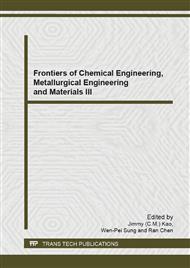[1]
M. P. Staiger, A. M. Pietak, J. Huadmai, et al. Magnesium and its alloys as orthopedic biomaterials: A review. Biomaterial. 27 (2006) 1728-1734.
DOI: 10.1016/j.biomaterials.2005.10.003
Google Scholar
[2]
Z. Y. Hou, L. X. Liu, R. S. Liu, et al. Short-range and medium-range order in Ca7Mg3 metallic glass. J. Appl. Phys. 107 (2010) 083511-083517.
DOI: 10.1063/1.3357304
Google Scholar
[3]
L. L. Zhou, R. S. Liu, Z. A. Tian. Simulation of formation and evolution of nano-clusters during rapid solidification of liquid Ca70Mg30 alloy. Trans. Nonferrous Met. Soc. China. 23 (2013) 2354-2360.
DOI: 10.1016/s1003-6326(13)62741-7
Google Scholar
[4]
M. B. Kannan, R. K. S. Raman. In vitro degradation and mechanical integrity of calcium-containing magnesium alloys in modified-simulated body fluid. Biomaterial. 29 (2008) 2306-2314.
DOI: 10.1016/j.biomaterials.2008.02.003
Google Scholar
[5]
Y. Q. Cheng, E. Ma. Atomic-level structure and structure–property relationship in metallic glasses. Progress in Materials Science. 56 (2011) 379-473.
DOI: 10.1016/j.pmatsci.2010.12.002
Google Scholar
[6]
S. Wang, S. K. Lai. Structure and electrical resistivities of liquid binary alloys. J. Phys. F: Metal. Phys. 10 (1980) 2717-2737.
DOI: 10.1088/0305-4608/10/12/012
Google Scholar
[7]
D. H. Li, X. R. Li, S. Wang. Variational calculation of Helmholtz free energies with applications to the sp-type liquid metals. J. Phys. F: Metal. Phys. 16 (1986) 309-321.
DOI: 10.1088/0305-4608/16/3/010
Google Scholar
[8]
S. S. Jaswal, J. Hafner. Atomic and electronic structure of crystalline and amorphous alloys. I. Calcium-magnesium compounds. Phys. Rev. B. 38 (1988) 7311-7319.
DOI: 10.1103/physrevb.38.7311
Google Scholar
[9]
K. Vollmayr, W. Kob, K. Binder. How do the properties of a glass depend on the cooling rate? A computer simulation study of a Lennard-Jones system. J. Chem. Phys. 105 (1996) 4714-4728.
DOI: 10.1063/1.472326
Google Scholar
[10]
J. D. Honeycutt, H. C. Anderson. Molecular-dynamics study of melting and freezing of small Lennard-Jones clusters. J. Phys. Chem. 91 (1987) 4950-4963.
DOI: 10.1021/j100303a014
Google Scholar
[11]
R. S. Liu, K. J. Dong, Z. A. Tian, et al. Formation and magic number characteristics of clusters formed during solidification processes. J. Phys.: Condens. Matter. 19 (2007) 196103-196117.
DOI: 10.1088/0953-8984/19/19/196103
Google Scholar
[12]
F. X. Liu, R. S. Liu, Z. Y. Hou, et al. Formation mechanism of atomic cluster structures in Al-Mg alloy during rapid solidification processes. Ann. Physics. 324 (2009) 332-342.
DOI: 10.1016/j.aop.2008.10.010
Google Scholar
[13]
R. S. Liu, H. R. Liu, C. X. Zhen, et al. Microstructure Transition of Liquid Metal Al During Heating and Cooling Processes. Chin. Phys. Lett. 18 (2001) 1383-1385.
Google Scholar


